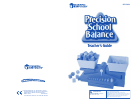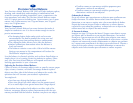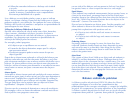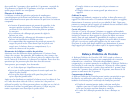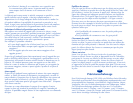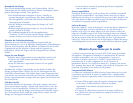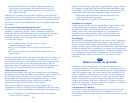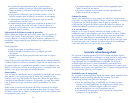
Precision School Balance
Your Precision School Balance (LER 2420) will help students explore,
develop, and extend their understanding of mathematical and
scientific concepts including inequalities, mass, comparisons, the
four operations, and order. The Precision School Balance comes
with a 10-piece gram set including two 1-gram masses, two 2-gram
masses, two 5-gram masses, two 10-gram masses, one 20-gram
mass, one 50-gram mass.
Balance Components
Your Precision School Balance has many features that make it
simple for students to use. It is also accurate enough to use for
precise measurements.
• The damping button helps make quick and accurate
measurements. The button steadies the swing arm and
prevents the pans from rocking during a measurement.
• The calibration slider allows you to zero the balance.
• Marked calibrations demonstrate when the balance is
level and zeroed.
• The balance contains a case with a lid to hold the masses.
Storing your masses in this compartment will reduce the
likelihood of misplacing them.
Use the balance in directed activities such as those listed below or
simply place it in a Learning Center for students to explore. Either
way, your Precision School Balance will expand and enrich the
learning opportunities in your classroom.
Exploring the Precision School Balance
Collect a variety of classroom objects such as: pencils, erasers, paper
clips, scissors, counters, or blocks. Encourage students to place
objects on either side of the balance and observe the results. Ask
questions that will increase your students’ explorations.
You might ask:
• Are there any objects that balance each other?
• Does size always tell which object has the greatest mass?
• Can a small object have greater mass than a large object?
After students have explored with objects on either side of the
balance, encourage them to explore measurement with the unit
masses provided with the balance. Students can place one object
2 15
E
• É melhor começar com massas unitárias pequenas para
determinar a massa de um objecto?
• É melhor começar com massas unitárias grandes para
determinar a massa de um objecto?
Ordenação de Massas
Peças aos alunos para organizarem os objectos que recolheram em
função da massa. Os alunos devem seleccionar um objecto,
determinar a sua massa e registar este valor numa tabela de dados.
Depois de fazerem isto para todos os objectos, os alunos devem
organizá-los por ordem de grandeza, começando com o objecto de
menor massa até ao objecto de maior massa.
À Procura da Massa
Imagine um jogo "À Procura da Massa"! Segure num objecto e peça
aos alunos para o identificar e em seguida determinar a sua massa.
Desafie-os a procurarem na sala de aulas outro objecto com massa
semelhante. Dê a cada aluno a oportunidade de seleccionar e rejeitar
objectos até estarem de acordo relativamente ao objecto que pensam
ter a massa mais semelhante à do objecto que seleccionou. Discuta a
selecção feita pelos alunos e em seguida determine as massas dos
objectos mais seleccionados para encontrar a melhor resposta.



